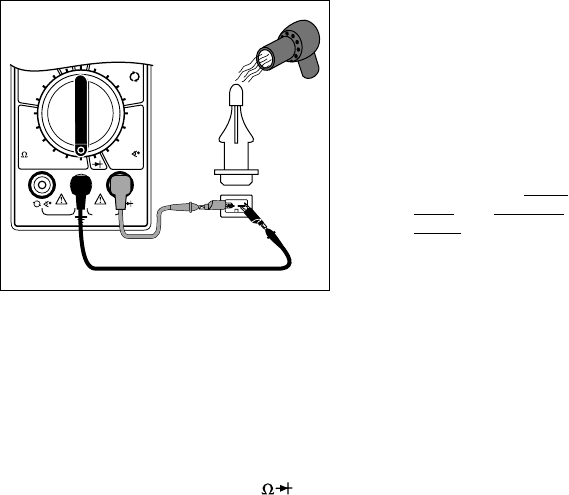
4
CYL
5
CYL
6
CYL
8
CYL
2K
200
200
750
20
2
20M
2M
200K
20K
OHMS
R
P
M
X
1
0
750V AC
200V DC
COM
V
DWELL
4
CYL
5
CYL
6
CYL
8
CYL
Temperature Type Sensors
30
Fig. 28
Test Procedure (see Fig. 28):
1. If engine is HOT let it COOL down
before proceeding.
Make sure all engine and transmission
fluids are at outside air temperature
before proceeding with this test!
2. Insert BLACK test lead into the COM
test lead jack.
3. Insert RED test lead into the
V
test
lead jack.
4. Disconnect wiring harness from
sensor.
5. If testing Intake Air Temperature
Sensor - Remove it from vehicle.
All other temperature sensors can remain
on vehicle for testing.
6. Connect RED test lead to either sensor
pin.
7. Connect BLACK test lead to remaining
sensor pin.
8. Turn multimeter rotary switch to
desired OHM range.
If the approximate resistance is unknown,
start at the largest OHM range and
decrease to the appropriate range as
required. (See Setting the Range on page
6)
9. View and record reading on display.
10.Disconnect multimeter test leads from
sensor and reconnect sensor wiring.
This step does not apply to intake air
temperature sensors. For intake air
temperature sensors, leave multimeter
test leads still connected to sensor.
11.Heat up sensor.
If testing Intake Air Temperature Sensor:
To heat up sensor dip sensor tip into
boiling water, or...
Heat tip with a lighter if sensor tip is
metal or a hair dryer if sensor tip is
plastic.
View and record smallest reading on
display as sensor is heated.
You may need to decrease the range to
get a more accurate reading.
For all other temperature sensors:
Start engine and let idle until upper
radiator hose is warm.
Turn ignition key OFF.
Disconnect sensor wiring harness and
reconnect multimeter test leads.
View and record reading on display.
12.Test Results.
Good Sensor:
Temperature sensors HOT resistance is
at least 300ý less than its COLD
resistance.
The key point is that the COLD
resistance decreases with increasing
temperature.
Bad Sensor:
There is no change between the
temperature sensors HOT resistance
from the COLD resistance.
The temperature sensor is an open or a
short circuit.
A temperature sensor is a thermistor or a
resistor whose resistance changes with
temperature. The hotter the sensor gets, the
lower the resistance becomes. Typical
thermistor applications are engine coolant
sensors, intake air temperature sensors,
transmission fluid temperature sensors, and
oil temperature sensors.
Black
Hair Dryer
Typical
Intake Air
Temperature
Sensor
Red


















